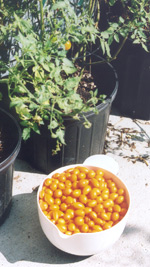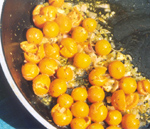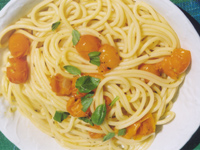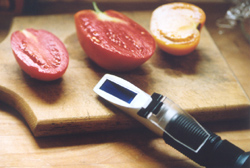
A great recipe that takes 32 minutes to prepare, and works great even if you cook just for one person.
Plus some interesting facts on tomato paste ... the base of many pasta dishes.
If you wish to review, last year I have published a whole web page on how I preserve my tomato (2 canning methods) click here to review.

An award winning recipe
I'm confident you will love this recipe because it's great, fast and easy to prepare. Works best for one/two people or small portions.
Ingredients for one:
- 6 oz. cherry tomatoes
- 6 oz. spaghetti
- 6 table spoon olive oil
- 2 bulbs of French shallot
- Italian spices, sea salt and basil
Prepare the ingredients as the water is boiling.
Toss the pasta (spaghetti is the best choice for this recipe) in the water. Spaghetti take about 11 - 12 minutes to cook. Your sauce will take about 10 minutes, so start the sauce after tossing the pasta.
- Mince the shallot bulbs finely
- Cut most of the cherry tomatoes in half (leave a few whole - it looks nice in the dish)
- Keep your sea salt and Italian spices handy

Keep this sauce moist. As it cooks it will dry up quickly. Take a laddle of starchy water from the spaghetti pot as needed. Add the Italian spices and a pinch of sea salt.

Make sure the sauce coats all the pasta in the pan and add a table spoon of olive oil to finish.
Serve in a dish with a few leaves of basil.
No cheese please! Don't spoil the complex taste of the sweet tomatoes and shallots.

Can you measure the sweetness of a tomato? Sure, you can!

A refractiometer is an optical instrument developed by the German scientist Dr. Brix.
See the blue square, it is a lens. Put a few drops of tomato juice on the lens and expose it to the sun light. The light travels through the juice like a crystal and generates a refraction.
Is this something new? Certainly not. This instrument is used all the time to measure sugar content of grape. That's how the grape growers are paid when they deliver the crops to the wine maker. Low sugar content equals to lower price.
You should demand to pay your grocery tomato based on the BRIX count!
By the way, the fantastic Super-sweet cherry tomatoes measure 9 BRIX on average, the best paste tomatoes come in at 6 BRIX, green tomatoes score only two BRIX.
2003 weather: 10-15 degrees F below the seasonal average in June/July and severe drought (12" of rain April - mid September).
Harvest notes:
- Kenosha Paste Tomato: few plants without any bottom rot. Harvest poor.
- Rick's Amish Paste: plants looked similar to last year.
- Rick's Roma Plum: impressive yield - no bottom rot.
- Super-sweet Gold Cherry: great! No splitting at all.
- the weight of the raw tomatoes in pounds,
- the amount of juice in pints before the cooking down process,
- BRIX reading of the raw juice,
- PM stands for Process Method for the juice extraction (click here to review),
- hours of cooking (for PM2 the time of cooking the tomato before extracting the juice is also included), and to that time add 30 min. of pressure cooking at 10 pounds of pressure,
- the number of pint jars filled,
- and the final BRIX count of the sauce / paste.
|
|
|
|
|
|
|
|
|
|
|
Rick's Amish Tomato
|
|
|
|
|
|
|
|
|
|
|
|
|
|
|||||
|
Rick's Roma Plum
|
|
|
|
|
|
|
|
|
|
Super-sweet Cherry
|
|
|
|
|
|
|
|
|
|
Kenosha Paste 9/15
|
|
|
|
|
|
|
|
|
|
|
|
|
|
|||||
|
Kenosha Paste 9/28
|
|
|
|
|
|
|
||
|
|
|
|
||||||
|
Total
|
|
|
|
a) I use an 8-quarts pot to cook down the juice - when I have more juice than what fits in the pot I use a smaller pot in addition. The juice in the smaller pot (initial volume about 4 pints) cooked down to a thicker paste than the same juice that cooked in the larger pot (initial volume of juice ??) -- the BRIX reading of the thicker paste after the same amount of hours of cooking measured 2 points higher. This may prove that the total time of cooking alone does not change the BRIX reading. The higher concentration of sugar is due to the lower ratio of moisture in the paste - the initial quantity of 20 pints lost about 1/3 of the moisture.
b) Interesting to note how the Amish tomato starts off with a sweeter juice by just one BRIX point and doubles in sweetness after 6 hours of cooking, while the Roma Plum tomato only increases by 2 points. The Roma Plum is definitely the best tomato for thick sauce, using PM2, perfect for pizza.
c) Granted one person must be insane like me to extract juice and make paste with cherry tomatoes, but when you are crazy for good food, you do crazy things! Processed following a spin-off of the PM2 extraction; you have to add water in the pot when you first cook the little tomatoes in a kitchen towel to avoid burning. I have first cooked them for one hour and then processed 5 times through the tomato press.
d) I took a reading of the juice immediately after extraction (the tomato-halves cooked for a minimum of 30 minutes in the oven at 450 degrees F before going through the tomato press) and recorded a BRIX count of 7. After 3 hours of cooking on very low flame less than a cup of moisture has evaporated - the BRIX count raised to 7.5. More reading after 4 hours the BRIX count reached 8; after 6 hours 9.5 and after 9 hours 10.5. Since the sauce still looks quite moist (I estimate that about 3 pints of moisture have evaporated = less than 20%) after 9 hours at very low flame, Iets go the distance and see where the BRIX count goes. As midnight is aproaching I pull 10 pints of sauce that measures 11 BRIX and start the pressure cooker.
e) As the pressure cooker warms up, I measure the sauce that is at the bottom of the pot and take one reading at 13 and a second reading at 14 BRIX. The sauce is not as thick as the one obtained with Roma Plums. 14 hours to process a batch of tomatoes but the result is outstanding! Next time I'll start sooner.
f) Two weeks later I have processed more tomatoes of the Kenosha Paste variety. The BRIX measure of the raw juice appears equal or superior than in mid September. With less cooking time available, the juice reached 9.5 BRIX in 6 hours in the 8-quarts pot. The smaller amount of juice that cooked in a 4-quarts pot reached a much thicker consistency in the same amount of time (paste with possibly only 10% of moisture). The BRIX count of this paste measured 17.
g) Bottom line: it takes about two pounds of tomato to obtain a pint of sauce. This web page is a work in progress. Bookmark it and come back to read about the results on "end of the season" fruit and comments on changes due to aging of the sauce canned in jars.
I look forward to read your comments. Click here to email. Please mention Ref. N0337 so I know the source of your comments.
If you know someone that is not receiving our newsletter, click here to sign-them-up.
Looking forward to meet you at the Harbor MarketPlace on market day.
Your friends,
Curzio